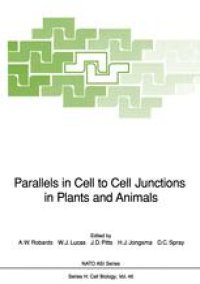
Ebook: Parallels in Cell to Cell Junctions in Plants and Animals
- Tags: Plant Sciences, Cell Biology, Biochemistry general
- Series: NATO ASI Series 46
- Year: 1990
- Publisher: Springer-Verlag Berlin Heidelberg
- Edition: 1
- Language: English
- pdf
Intracellular junctions provide routes for direct cell-to-cell signalling in both plants and animals. The present volume treats the parallels and differences between such junctions in animals and plants and discusses the most recent methods of examining the physiological functions and regulation of intracellular communication. Strong evidence of both molecular as well as functional simi§ larities between plasmodesmata and gap junctions is increasing. Even more interesting is the discovery that animal gap junction proteins cross-react immunologically with some proteins in plant cells. Thus the molecular construction and function of these crucially important ultrastructural cell components is now open to a concerted research effort to understand how cells, both plant and animal, facilitate and regulate intercellular transport.
Intracellular junctions provide routes for direct cell-to-cell signalling in both plants and animals. The present volume treats the parallels and differences between such junctions in animals and plants and discusses the most recent methods of examining the physiological functions and regulation of intracellular communication. Strong evidence of both molecular as well as functional simi§ larities between plasmodesmata and gap junctions is increasing. Even more interesting is the discovery that animal gap junction proteins cross-react immunologically with some proteins in plant cells. Thus the molecular construction and function of these crucially important ultrastructural cell components is now open to a concerted research effort to understand how cells, both plant and animal, facilitate and regulate intercellular transport.
Intracellular junctions provide routes for direct cell-to-cell signalling in both plants and animals. The present volume treats the parallels and differences between such junctions in animals and plants and discusses the most recent methods of examining the physiological functions and regulation of intracellular communication. Strong evidence of both molecular as well as functional simi§ larities between plasmodesmata and gap junctions is increasing. Even more interesting is the discovery that animal gap junction proteins cross-react immunologically with some proteins in plant cells. Thus the molecular construction and function of these crucially important ultrastructural cell components is now open to a concerted research effort to understand how cells, both plant and animal, facilitate and regulate intercellular transport.
Content:
Front Matter....Pages I-VIII
Structural and Molecular Diversity of Gap Junctions....Pages 1-12
A Structural Analysis of the Gap Junctional Channel and the 16K Protein....Pages 13-19
Molecular Heterogeneity of Gap Junctions in Different Mammalian Tissues....Pages 21-34
Biochemical and Structural Properties of the Protein Constituent of Junctional Domains in Eye Lens Fiber Plasma Membranes....Pages 35-52
Junctional Communication: The Role of Communication Compartments in Complex Multicellular Organisms....Pages 53-62
Electrophysiological Properties of Gap Junction Channels....Pages 63-85
Cardiac Gap Junctions: Gating Properties of Single Channels....Pages 87-99
Patterns of Gap Junctional Permeability in Developing Insect Tissues....Pages 101-113
Gap Junctional Intercellular Communication and Carcinogenesis....Pages 115-127
Progressive Restrictions in Gap Junctional Communication during Development....Pages 129-143
The Neck Region of Plasmodesmata: General Architecture and Some Functional Aspects....Pages 145-170
Immunological Investigations of Relatedness between Plant and Animal Connexins....Pages 171-183
Secondary Formation of Plasmodesmata in Cultured Cells - Structural and Functional Aspects....Pages 185-197
Distribution of Plasmodesmata in Leaves. A Comparison of Cananga Odorata with Other Species Using Different Measures of Plasmodesmatal Frequency....Pages 199-221
Plasmodesmatal Structure and Function in Nectaries....Pages 223-237
Analytical Studies of Dye-Coupling between Plant Cells....Pages 239-248
Function and Localisation of Movement Proteins of Tobacco Mosaic Virus and Red Clover Mottle Virus....Pages 249-259
Plasmodesmata - Virus Interaction....Pages 261-274
Back Matter....Pages 275-287
Intracellular junctions provide routes for direct cell-to-cell signalling in both plants and animals. The present volume treats the parallels and differences between such junctions in animals and plants and discusses the most recent methods of examining the physiological functions and regulation of intracellular communication. Strong evidence of both molecular as well as functional simi§ larities between plasmodesmata and gap junctions is increasing. Even more interesting is the discovery that animal gap junction proteins cross-react immunologically with some proteins in plant cells. Thus the molecular construction and function of these crucially important ultrastructural cell components is now open to a concerted research effort to understand how cells, both plant and animal, facilitate and regulate intercellular transport.
Content:
Front Matter....Pages I-VIII
Structural and Molecular Diversity of Gap Junctions....Pages 1-12
A Structural Analysis of the Gap Junctional Channel and the 16K Protein....Pages 13-19
Molecular Heterogeneity of Gap Junctions in Different Mammalian Tissues....Pages 21-34
Biochemical and Structural Properties of the Protein Constituent of Junctional Domains in Eye Lens Fiber Plasma Membranes....Pages 35-52
Junctional Communication: The Role of Communication Compartments in Complex Multicellular Organisms....Pages 53-62
Electrophysiological Properties of Gap Junction Channels....Pages 63-85
Cardiac Gap Junctions: Gating Properties of Single Channels....Pages 87-99
Patterns of Gap Junctional Permeability in Developing Insect Tissues....Pages 101-113
Gap Junctional Intercellular Communication and Carcinogenesis....Pages 115-127
Progressive Restrictions in Gap Junctional Communication during Development....Pages 129-143
The Neck Region of Plasmodesmata: General Architecture and Some Functional Aspects....Pages 145-170
Immunological Investigations of Relatedness between Plant and Animal Connexins....Pages 171-183
Secondary Formation of Plasmodesmata in Cultured Cells - Structural and Functional Aspects....Pages 185-197
Distribution of Plasmodesmata in Leaves. A Comparison of Cananga Odorata with Other Species Using Different Measures of Plasmodesmatal Frequency....Pages 199-221
Plasmodesmatal Structure and Function in Nectaries....Pages 223-237
Analytical Studies of Dye-Coupling between Plant Cells....Pages 239-248
Function and Localisation of Movement Proteins of Tobacco Mosaic Virus and Red Clover Mottle Virus....Pages 249-259
Plasmodesmata - Virus Interaction....Pages 261-274
Back Matter....Pages 275-287
....